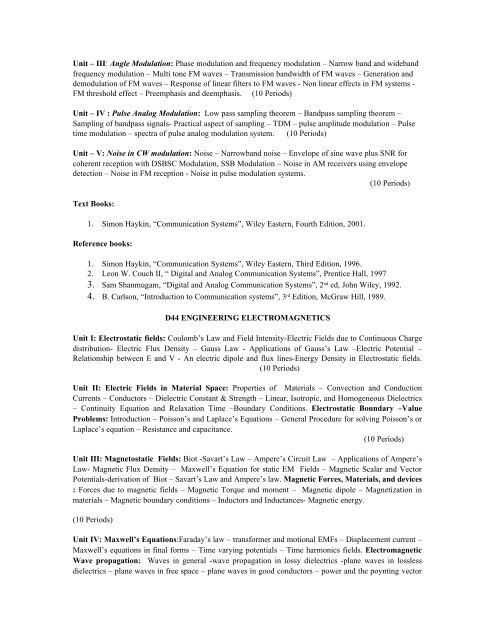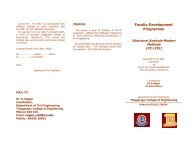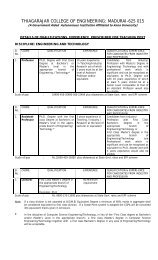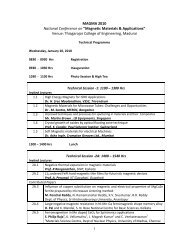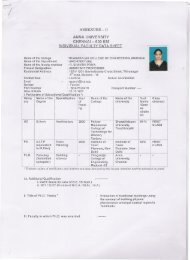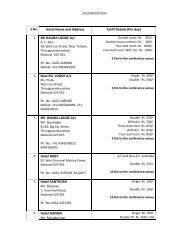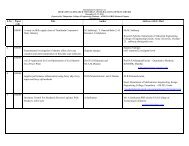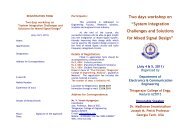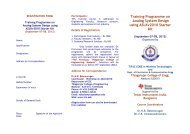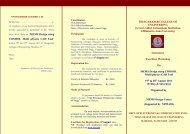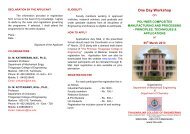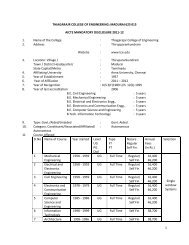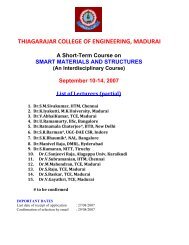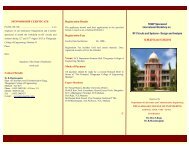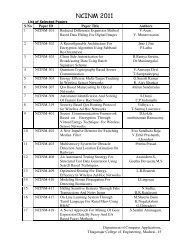THIAGARAJAR COLLEGE OF ENGINEERING: MADURAI – 625 015 ...
THIAGARAJAR COLLEGE OF ENGINEERING: MADURAI – 625 015 ...
THIAGARAJAR COLLEGE OF ENGINEERING: MADURAI – 625 015 ...
- TAGS
- thiagarajar
- college
- madurai
- tce.edu
You also want an ePaper? Increase the reach of your titles
YUMPU automatically turns print PDFs into web optimized ePapers that Google loves.
Unit <strong>–</strong> III: Angle Modulation: Phase modulation and frequency modulation <strong>–</strong> Narrow band and wideband<br />
frequency modulation <strong>–</strong> Multi tone FM waves <strong>–</strong> Transmission bandwidth of FM waves <strong>–</strong> Generation and<br />
demodulation of FM waves <strong>–</strong> Response of linear filters to FM waves - Non linear effects in FM systems -<br />
FM threshold effect <strong>–</strong> Preemphasis and deemphasis. (10 Periods)<br />
Unit <strong>–</strong> IV : Pulse Analog Modulation: Low pass sampling theorem <strong>–</strong> Bandpass sampling theorem <strong>–</strong><br />
Sampling of bandpass signals- Practical aspect of sampling <strong>–</strong> TDM <strong>–</strong> pulse amplitude modulation <strong>–</strong> Pulse<br />
time modulation <strong>–</strong> spectra of pulse analog modulation system. (10 Periods)<br />
Unit <strong>–</strong> V: Noise in CW modulation: Noise <strong>–</strong> Narrowband noise <strong>–</strong> Envelope of sine wave plus SNR for<br />
coherent reception with DSBSC Modulation, SSB Modulation <strong>–</strong> Noise in AM receivers using envelope<br />
detection <strong>–</strong> Noise in FM reception - Noise in pulse modulation systems.<br />
(10 Periods)<br />
Text Books:<br />
1. Simon Haykin, “Communication Systems”, Wiley Eastern, Fourth Edition, 2001.<br />
Reference books:<br />
1. Simon Haykin, “Communication Systems”, Wiley Eastern, Third Edition, 1996.<br />
2. Leon W. Couch II, “ Digital and Analog Communication Systems”, Prentice Hall, 1997<br />
3. Sam Shanmugam, “Digital and Analog Communication Systems”, 2 nd ed, John Wiley, 1992.<br />
4. B. Carlson, “Introduction to Communication systems”, 3 rd Edition, McGraw Hill, 1989.<br />
D44 <strong>ENGINEERING</strong> ELECTROMAGNETICS<br />
Unit I: Electrostatic fields: Coulomb’s Law and Field Intensity-Electric Fields due to Continuous Charge<br />
distribution- Electric Flux Density <strong>–</strong> Gauss Law - Applications of Gauss’s Law <strong>–</strong>Electric Potential <strong>–</strong><br />
Relationship between E and V - An electric dipole and flux lines-Energy Density in Electrostatic fields.<br />
(10 Periods)<br />
Unit II: Electric Fields in Material Space: Properties of Materials <strong>–</strong> Convection and Conduction<br />
Currents <strong>–</strong> Conductors <strong>–</strong> Dielectric Constant & Strength <strong>–</strong> Linear, Isotropic, and Homogeneous Dielectrics<br />
<strong>–</strong> Continuity Equation and Relaxation Time <strong>–</strong>Boundary Conditions. Electrostatic Boundary <strong>–</strong>Value<br />
Problems: Introduction <strong>–</strong> Poisson’s and Laplace’s Equations <strong>–</strong> General Procedure for solving Poisson’s or<br />
Laplace’s equation <strong>–</strong> Resistance and capacitance.<br />
(10 Periods)<br />
Unit III: Magnetostatic Fields: Biot -Savart’s Law <strong>–</strong> Ampere’s Circuit Law <strong>–</strong> Applications of Ampere’s<br />
Law- Magnetic Flux Density <strong>–</strong> Maxwell’s Equation for static EM Fields <strong>–</strong> Magnetic Scalar and Vector<br />
Potentials-derivation of Biot <strong>–</strong> Savart’s Law and Ampere’s law. Magnetic Forces, Materials, and devices<br />
: Forces due to magnetic fields <strong>–</strong> Magnetic Torque and moment <strong>–</strong> Magnetic dipole <strong>–</strong> Magnetization in<br />
materials <strong>–</strong> Magnetic boundary conditions <strong>–</strong> Inductors and Inductances- Magnetic energy.<br />
(10 Periods)<br />
Unit IV: Maxwell’s Equations:Faraday’s law <strong>–</strong> transformer and motional EMFs <strong>–</strong> Displacement current <strong>–</strong><br />
Maxwell’s equations in final forms <strong>–</strong> Time varying potentials <strong>–</strong> Time harmonics fields. Electromagnetic<br />
Wave propagation: Waves in general -wave propagation in lossy dielectrics -plane waves in lossless<br />
dielectrics <strong>–</strong> plane waves in free space <strong>–</strong> plane waves in good conductors <strong>–</strong> power and the poynting vector


